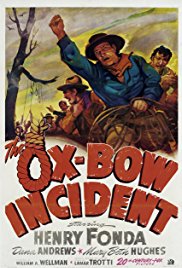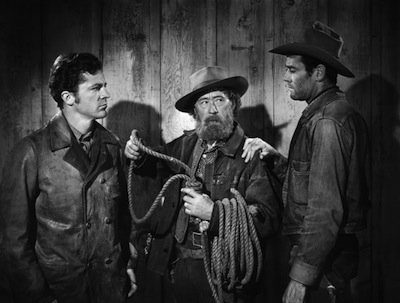See Assignments, Projects, and Activities for Use With Any Film that is a Work of Fiction.
AN EXERCISE IN CREATING THEMATIC STATEMENTS USING THE OX-BOW INCIDENT
(The film or the book)
Age: 12+
Length: One 45 to 55 minute class period.
Learner Outcomes/Objectives: Students will practice the ability to derive theme and create thematic statements for a work of fiction.
Rationale: This exercise will assist students in deriving theme and writing thematic statements. Note that the same process can be used with any fictional work.
Preparation: Show the film The Ox-Bow Incident and review selected ELA Discussion Questions with the class. Write on the board each of the four topics listed below leaving enough room beneath each topic to write out several possible thematic statements.
Step by Step:
1. Have students take out a piece of paper and a pencil and have them on their desks before the exercise begins. They should write out the four topics leaving enough space below each topic for their thematic statements. The four topics are: justice, conformity, masculine role model, and guilt.
2. Define Thematic Statement: A thematic statement expresses a theme of a work of fiction in a single sentence.
3. Define Theme: If necessary, familiarize students with a helfpul definition of the term “theme”. A suggested definition is set out below.
A theme in a poem, novel, story, play or film is a message about life or human nature which the author or filmmaker believes to be universally true. A theme involves an observation about life. It weighs, and considers actions and ideas. A theme is an arguable abstraction that proposes a universal truth about life or human nature.
A theme is not merely a topic, a suggestion, a fact, or a question. This is because a theme is an important meaning contained in the work. Topics, such as “love” and “justice” have no meaning. A suggestion is not emphatic enough to convey meaning. A fact, such as “Obese people have a lower life expectancy than people who are not obese” is universally true and perhaps very important for obese people and those who love them, but it’s not interesting enough for a work of fiction. A question has no meaning in itself. The meaning is in the answer.
Nor are moral judgments or directives about how people should behave, proper statements of theme. They are not observations about life or about human nature. Words like “should” and “ought” do not belong in thematic statements.
A theme does not summarize the plot of a work of fiction nor does it mention characters by name. These are not statements about life but about the work itself. Instead, themes may refer generally to types of situations and types of people such as men, women, leaders, the accused, vigilantes, society, young people etc.
Authors usually try to communicate messages that are more complex and subtle than trite statements or aphorisms. This is especially true of works of fiction that are presented to students in English classes. Themes of “love is blind” or “what goes around comes around” don’t usually make for interesting reading or viewing. When stating a theme, look for something less obvious and more intriguing.
There may be more than one theme in a work of fiction.
In stating a theme be very careful about the use of superlatives and absolutes; don’t use them unless you are absolutely sure. The “best,” the “worst,” “all,” “none,” “everyone,” “always” and the like are usually not the type of precise thinking used by authors seeking to state universal truth.
Most themes are not directly stated in the work; instead, they are implied. If a theme is not immediately apparent, it can be derived by focusing on the various elements of the work, such as title; plot; motifs; symbols; changes in the characters over the course of the story, or realizations characters come to have during the story. Sometimes, hints as to theme can be found in unusual objects, mysterious characters, significant animals, repeated names, songs or any element in the story that hints of a meaning beyond the surface.
4. Ask students, either individually or working in small groups to write on their paper one sentence that makes clear what the film is actually saying about each topic.
5. Select four students or a student from each group to write their thematic statements on the board and see if, through discussion, the class can agree on one theme for each topic. The students may enter into debate over definitions of words and should be able to refer to the film or book in order to support their points.
Examples of possible thematic statements follow the topics.
Justice:
- Justice cannot be achieved without due process.
- Injustice is a function of mob rule.
- Justice requires the application of reasoned judgment and the ability to delay the gratification of punishing those thought to be guilty of a crime.
The following are not good examples of thematic statements on the topic of justice:
- Justice is an important value.
- justice is wrong.
- The value of justice.
- Conformity:
- Fear drives conformity.
- Conformity requires compromise.
- Individuality and conformity cannot coexist
The following are not good examples of thematic statements on the topic of conformity:
- You should not give in to conformity.
- People who conform give up a part of themselves.
- The men in the mob conformed to the dictates of the Major.
Masculine role identity:
- Immature ideas of masculine identity require strict conformity.
- Fear drives adherence to the requisites of an immature and strictly defined male identity.
- Standing up for what is right is a requisite for a mature male role identity.
The following are not good examples of thematic statements on the topic of masculine role identity:
- Men feel they have to be tough to be men.
- A man should be himself no matter what others think.
- Men who are afraid to stand up for what is right are not manly.
Guilt:
- Relief from guilt requires reparative action.
- Guilt is a consequence of committing an injustice.
- Self-reproach can destroy identity.
The following are not good examples of thematic statements on the topic of guilt:
- Guilt is a terrible thing.
- People should avoid actions that will make them feel guilty.
- You feel guilty when you go against your beliefs.
6. Assignment/Assessment: Teachers can require formal theme essays based upon the various thematic statements. Each essay must cite direct reference to action or dialogue in the film followed by comment on the citation and its connection to the theme.
WRITING ASSIGNMENTS — ENGLISH LANGUAGE ARTS
1. Present students with the information in Martin’s letter to his wife:
My dear wife: Mr. Davies will tell you what’s happening here tonight. He’s a good man, and he’s done everything he can for me. I suppose there’s some other good men here, too, only they don’t seem to realize what they’re doing. They’re the ones I feel sorry for ’cause it’ll be over for me in a little while, but they’ll have to go on remembering for the rest of their lives.
A man just naturally can’t take the law into his own hands and hang people without hurtin’ everybody in the world, ’cause then he’s just not breaking one law but all laws. Law is a lot more than words you put in a book, or judges or lawyers or sheriffs you hire to carry it out. It’s everything people ever have found out about justice and what’s right and wrong. It’s the very conscience of humanity. There can’t be any such thing as civilization unless people have a conscience, because if people touch God anywhere, where is it except through their conscience? And what is anybody’s conscience except a little piece of the conscience of all men that ever lived?
Ask students to write a formal explication of this powerful paragraph in which they explain its meaning and comment on the value of the thoughts presented.
2. Have the student’s write an alternative ending for this film in which they find a way for the mob to avoid the lynching and to return the men to town for a trial. This assignment can be done in small groups and presented to the class to determine which of the various endings may best illustrate theme and seem logical in its resolution.
3. Tell the students to write a paragraph characterizing Major Tetley and his son, Gerald. Ask them to consider whether the son’s character may be the cause or the result of the Major’s entrenched authoritarianism.
4. Ask the students to write an opinion piece about the inability of Gil and Art to stop the events that resulted in the hanging. What explains their powerlessness in the face of the posse? Seven men voted with Gil and Art to let the men live. How might they have affected a better outcome?
5. Students who have read the book will know that when the posse returns to town, Sheriff Risley hears about what had happened but vows to remain silent and does nothing about the lynching. He takes ten of the men in a new posse to find those who had assaulted, but not killed, Kinkaid. Ask students to write a paragraph about what is changed in terms of theme with the film’s rewritten ending and which of the two is more satisfying to a viewer.
WRITING ASSIGNMENTS — SOCIAL STUDIES AND CIVICS
6. Have students look at the list of points important in due process presented in the Helpful Background section of this guide. Then tell them to illustrate using scenes, dialogue or action how each of the points considered essential to justice is abused in the film.
7. Have students research the origins of due process and write a paper in which they detail at least ten rights that are guaranteed to the accused in criminal cases and describe the reason for those rights.
8. Have students review cases that have resulted in Supreme Court decisions reaffirming the value of due process. They may find cases wherein decisions have been reversed because of the state’s failure to adhere to the required procedures.
9. Have students write an opinion piece on their own relationship with due process as it may exist in their school. For example, what is the process that may result in suspension or expulsion from school in response to a disciplinary action?
10. Ask students to research and write about the concept of “reasonable doubt.” The information can be presented to the class as a whole and put to a debate.



